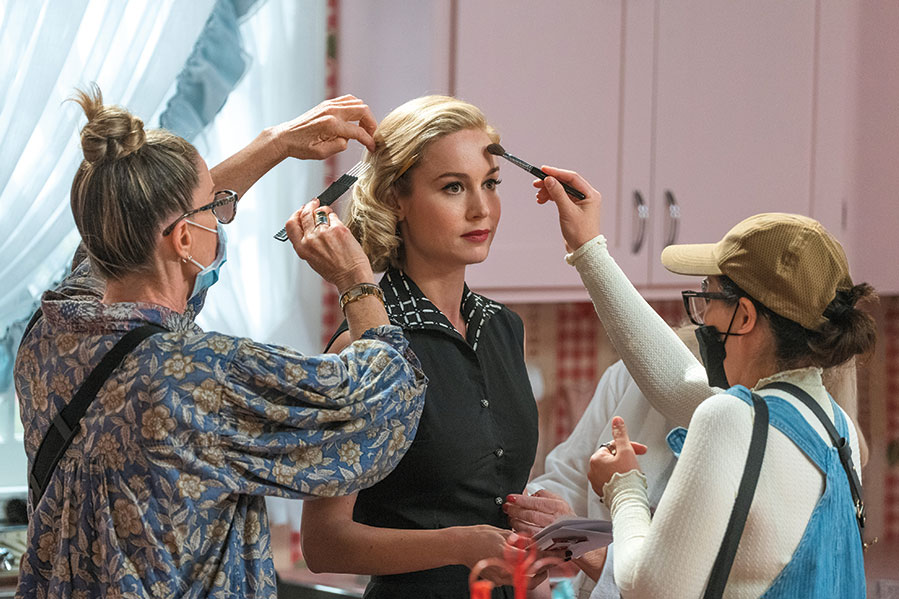
For some of the industry’s top pros, working on Lessons in Chemistry meant finding the right mixture of opposing elements.
As a cadre of makeup, hair, costume and production design experts joined forces to adapt Bonnie Garmus’s debut novel into an eight-episode limited series premiering October 13, they faced a protagonist defiantly not of her time.
Brie Larson (Captain Marvel) plays Elizabeth Zott, a brilliant scientist who eschews the styles of the nifty 1950s — even when destiny calls and she lands her own cooking show. Her preferred outfit? A lab coat and pocket protector.
“In the 1950s, women were very put together. They wore full makeup, did their hair and dressed up — even if they were just staying inside the house,” says Miho Suzuki (High Fidelity), who headed makeup for the series. “For Elizabeth, her importance was not in her appearance. Thus, I wanted her to look as raw as possible.”
It was a paradox for these pros to dress supporting cast in color-saturated A-line dresses and soft bob coiffures while using muted palettes and simple hairdos for their star. “There was one time when we did a big, round, sexy Marilyn Monroe–type [hair] look for Elizabeth [when she was rehearsing for her TV show], and we called it her ‘uncomfortable look,’” says hair department head Teressa Hill (Being the Ricardos).
Hill opted to put almost everyone, including background cast, in wigs, using some 225 of them, most made of human hair. “Yes, it was a huge undertaking,” she says, noting that each wig was initially fitted, then colored, permed and styled — and had to be re-set every night after use.
Filming during lockdown also complicated Hill’s efforts. “A lot of these actresses hadn’t had their hair cut during the pandemic, and — I’m not joking — some of them showed up with hair down to their waist.” All of which had to fit properly under a wig. When costume designer Mirren Gordon-Crozier (The Girl from Plainville) came up with her lookbook for Zott’s character, she knew she wasn’t dealing with a typical 1950s woman. So she turned elsewhere for inspiration, calling up images of Ingrid Bergman and Katharine Hepburn in their off-duty casual looks.
“You had to put yourself in Elizabeth’s shoes at that time period,” Gordon-Crozier says. “She isn’t interested in clothing that would draw attention — nothing revealing, no color that would draw the eye. Elizabeth is the type of person who doesn’t buy new clothes.”
So she opted for dusty, muted colors and nearly always garbed Zott in green. “It’s a color that’s hardly ever garish, and I think it’s something that she’d be drawn to because it’s earthy and neutral.”
While production designer Cat Smith, who won an Emmy in 2016 for Transparent, didn’t have to dress Zott, she did have to find places in Los Angeles that still look like the 1950s. “I’ve lived here all my life and have done extensive research of all the areas around here, how they looked decade by decade,” she says. Luckily, there are still a few neighborhoods — namely Pasadena and parts of Hollywood — where some untouched buildings did the job. Zott’s love interest, Calvin (Lewis Pullman, Outer Range), lives in a Craftsman-style house that Smith found in Pasadena, where exteriors and interiors were shot. “But I didn’t want it to be too dark, with a lot of dark wood paneling, so we remodeled it and then decorated it as a guy would, which is not much.”
The job got trickier later, because Zott decides to take a sledgehammer and remodel the kitchen into a laboratory. To accommodate filming that would jump back and forth in time, Smith’s crew devised a tiled countertop that could be removed in one piece. She also had to design laboratories — at Zott’s work and home — that rang true to the period and to the kind of experiments that would be taking place there. Happily, Smith’s husband, a physicist, was able to advise her about proper Bunsen burners for the era and how chemical reactions should look. “We made sure all these fake chemicals looked right and that their reactions rang true,” she says.
Perhaps the most fun set to design was Zott’s on-air kitchen, where she hosts her own cooking show. “I started designing it with the idea that it would be a beautiful 1950s kitchen,” Smith says. “But then Brie [Larson, also an executive producer] called and said, ‘You have to understand that this kitchen set has to be awful, because it’s what the owner of the TV station thinks is a woman’s dream kitchen.’” Smith took the ball and ran, designing a Pepto Bismol– pink kitchen with lots of bric-a-brac and frou-frou. “I adopted the Hollywood Regency style, which does have a lot of fun motifs and gingerbread stuff.”
Similarly, makeup artist Suzuki, who was nominated for an Emmy in 2020 for Big Little Lies, pushed Zott’s look for her TV show rehearsal, applying sky-blue eyeshadow, big eyelashes and bright pink lipstick, which all add to the character’s discomfort.
Luckily for Zott, her straightforward, scientific approach appeals to viewers, and she becomes a star who calls her own shots. No more big, bouncy curls or over-the-top makeup. Even that frilly apron goes away. After all, who needs an apron when you have a lab coat?
New episodes of Lessons In Chemistry stream Fridays on Apple TV+.
This article originally appeared in emmy magazine issue #11, 2023 under the title “Committed to the Craft.”
